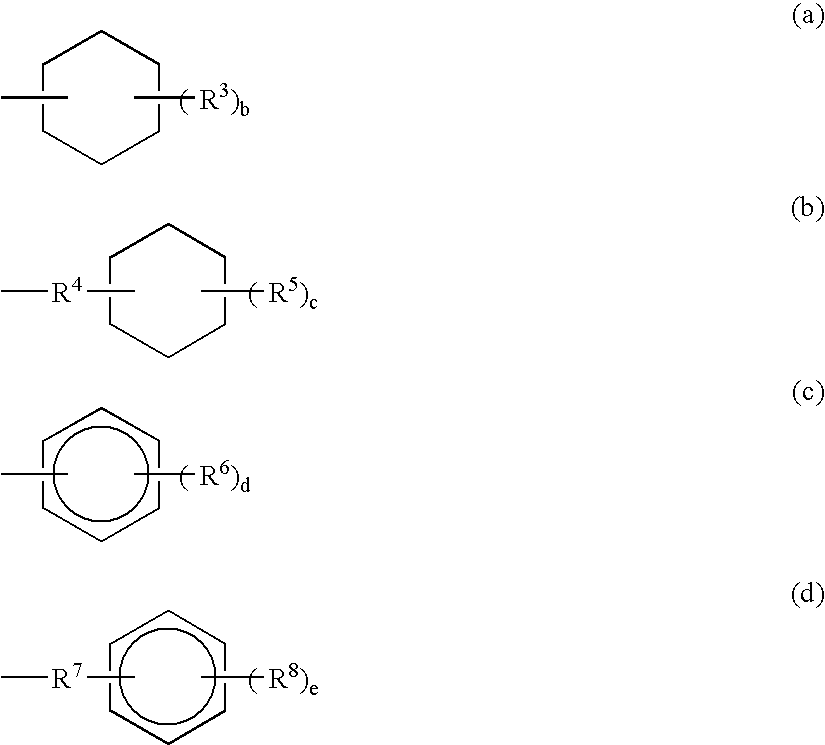Lactic acid polymer composition and molded object thereof
a technology of lactic acid and polymer, applied in the field can solve the problems of insufficient mechanical properties, environmental protection, and inability to meet the requirements of lactic acid-based polymer composition, and achieve the effects of impaired crystallinity and heat resistance of lactic acid-based polymer, insufficient flexibility and impact resistance, and insufficient mechanical properties
- Summary
- Abstract
- Description
- Claims
- Application Information
AI Technical Summary
Benefits of technology
Problems solved by technology
Method used
Image
Examples
production example 1
Under a nitrogen atmosphere, 0.03 mol of trimesic acid, 0.099 mol of cyclohexylamine, 0.099 mol of triphenyl phosphite, 10 g of pyridine and 50 g of N-methyl pyrrolidone were introduced into a 0.5 l flask equipped with a stirrer, a thermometer, a reflux condenser and a nitrogen gas inlet, and the reaction was carried out at 100° C. for 4 hours. The reaction mixture was cooled to room temperature and poured into 500 ml of 1:1 isopropyl alcohol / water mixture for reprecipitation. Filtration of the precipitate and drying gave the desired trimesic acid tricyclohexylamide. According to FT-IR analysis, the carboxyl group absorption peak disappeared and the amide group absorption peak (1633 cm−1) was observed, confirming the production of trimesic acid tricyclohexylamide.
Melting point: 384° C.
examples 1-23
An amide compound and an ester plasticizer shown in Table 1 and used in amounts specified therein were blended with 100 parts by weight of a polylactic acid (weight average molecular weight: 180000, L-lactic acid / D-lactic acid=97 / 3, manufactured by Shimadzu Corporation, trade name: “LACTY”) and the resulting mixture was kneaded at 200° C. with an extruder with a cylinder inner diameter of 20 mm (ratio of length / diameter=19, manufactured by Toyo Seiki Seisaku-sho Ltd., trade name: “Laboplastomill”). The resin composition extruded by nitrogen purging was cooled by water and pelletized with a pelletizer. The pellets thus obtained were vacuum-dried for 24 hours at 50° C. before being subjected to molding.
The dried pellets were placed in a press set at 200° C. and melted for 2 minutes, and the melt was pressed under a pressure of 100 kgf / cm2 at 200° C. for 5 minutes, and then crystallized under the conditions described in Table 1, thereby producing a sheet with a thickness of 0.5 mm a...
examples 24-26
An amide compound and an ester plasticizer shown in Table 3 and used in amounts specified therein were blended with 100 parts by weight of a polylactic acid (weight average molecular weight: 180000, L-lactic acid / D-lactic acid=97 / 3, manufactured by Shimadzu Corporation, trade name: “LACTY”) and kneaded at 200° C. with an extruder with a cylinder inner diameter of 20 mm (length / diameter: 19, manufactured by Toyo Seiki Seisaku-sho, Ltd., trade name: “Laboplastomill”). The resin composition extruded by nitrogen purging was cooled by water and pelletized with a pelletizer. The pellets thus obtained were vacuum-dried for 24 hours at 50° C. before being subjected to molding.
The dried pellets were molded with an injection molding machine (clamping pressure: 40 ton, manufactured by Nissei Plastic Industrial Co., Ltd.) at a barrel temperature of 160-200° C., injection time of 10 seconds, and mold temperature and cooling time as shown in Table 3, thereby giving a business card-sized plate ...
PUM
| Property | Measurement | Unit |
|---|---|---|
| thickness | aaaaa | aaaaa |
| transparency | aaaaa | aaaaa |
| transparency | aaaaa | aaaaa |
Abstract
Description
Claims
Application Information
 Login to View More
Login to View More - R&D
- Intellectual Property
- Life Sciences
- Materials
- Tech Scout
- Unparalleled Data Quality
- Higher Quality Content
- 60% Fewer Hallucinations
Browse by: Latest US Patents, China's latest patents, Technical Efficacy Thesaurus, Application Domain, Technology Topic, Popular Technical Reports.
© 2025 PatSnap. All rights reserved.Legal|Privacy policy|Modern Slavery Act Transparency Statement|Sitemap|About US| Contact US: help@patsnap.com



